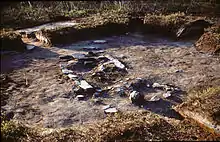Stallo
In the folklore of the Sami, a Stallo (also Stallu or Stalo) is a large, human-like creature who likes to eat people and who therefore is usually in some form of hostilities with a human. Stallos are clumsy and stupid, and thus humans often gain the upper hand over them.[1]

The Vindelfjällen Nature Reserve contains the remains of ancient, large building foundations, considered by the Sami to be the remains of Stallo dwellings. There is also a huge stone placed on some small pebbles on top near Lake Giengeljaure named stalostenen, which literally means "stone Stallo." Legend dictates that a Stallo would have placed a stone here to prove his strength.
Stallo sites

On account of the identification of relics of ancient buildings with the 'stallo' in the southern part of the Sámi area of Sweden, archaeologists have come to refer to such relics as 'stallo sites' generally, following the lead of Ernst Manker's 1960 study Fångstgropar och stalotomter ('hunting pits and stallo sites'). Such buildings are actually round or oval, with a diameter of four to six metres, arranged linearly in groups of two to eight (or, more rarely, more, up to fifteen). Around sixty such sites are known, distributed along what is now the Norway-Sweden border, from Frostviken in Jämtland county to the south, to Devddesvuopmi in Troms to the north. They are found above the tree line, at heights between 550 and 850 metres. They seem to have been in most extensive use around 800–1050 CE, that is, during the Viking Age. Scholars agree that these were temporary dwellings, probably for use in the warmer months, and that they reflect a change in the economic habits of their users, almost certainly associated with hunting or herding reindeer. But beyond this there is extensive debate. Were the inhabitants ethnically Norse or Sámi? Were their permanent habitations to the west, in Norway's fjords, or to the east, in Sweden's forests? Were the stallo sites bases for hunting or for pastoralist herding? As of 2014, debate was ongoing, but opinion at that time favoured the idea that the stallo sites were used by Sámi people, partly because the layout of the buildings corresponds to later Sámi dwellings.[2]
In folklore
The Stallo also appears in Sámi folktales,[3][4] such as How the Stalos were Tricked.
References
- Lars Levi Laestadius; Juha Pentikäinen & K. Börje Vähämäki (2002). Juha Pentikäinen (ed.). Fragments of Lappish mythology. K. Börje Vähämäki. Aspasia Books. p. 237. ISBN 9780968588192.
- Lars Ivar Hansen and Bjørnar Olsen, Hunters in Transition: An Outline of Early Sámi History, The Northern World: North Europe and the Baltic c. 400–1700 AD. Peoples, Economics and Cultures, 63 (Leiden: Brill, 2014), pp. 82-93; ISBN 978-90-04-25254-7.
- Friis, Jens Andreas. Lappiske eventyr og folkesagn. Christiania: Forlagt af Alb. Cammermeyer. 1871. pp. 73-110.
- Qvigstad, Just; Moltke Moe; G. Sandberg. Lappiske eventyr og folkesagn. Kristiania: 1877. pp. 62-67 and 146-164.
Further reading
- Andrew F. Besa. "The Stallo Throughout Sámi and World History". Sami Culture.
- Joann Conrad (1999–2000). Societas Uralo-Altaica (ed.). "Tracking the Ogre — the Sami Stallo". Ural-altaische Jahrbücher. O. Harrassowitz. 16: 56–75. ISSN 0174-0652.
